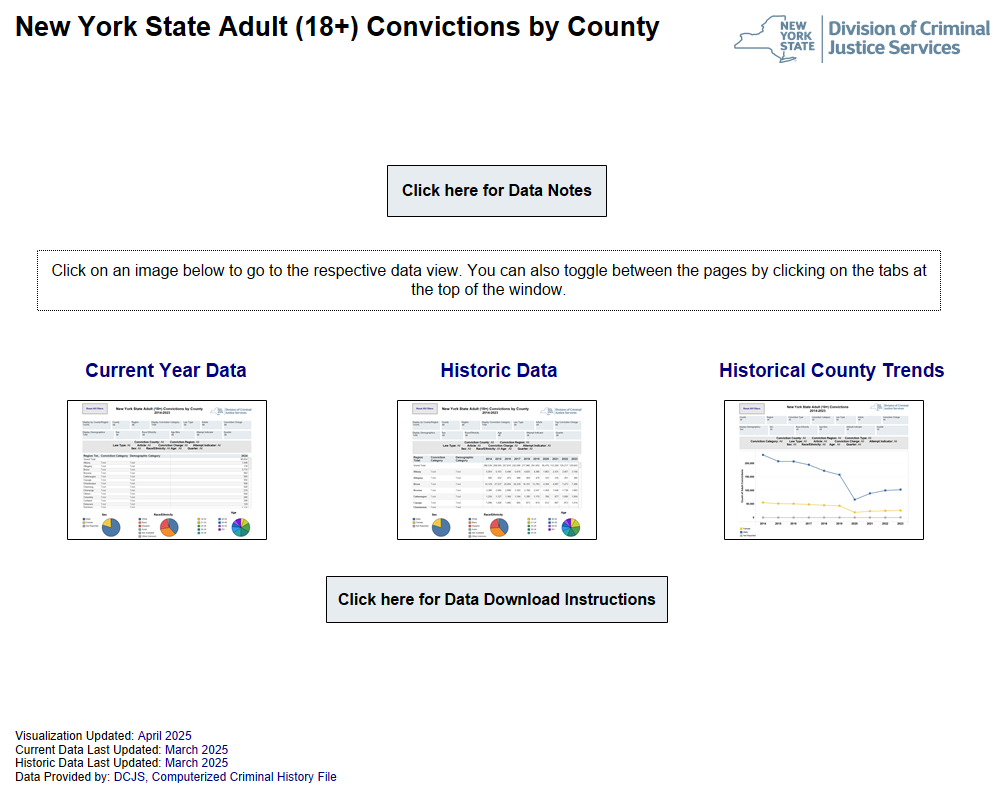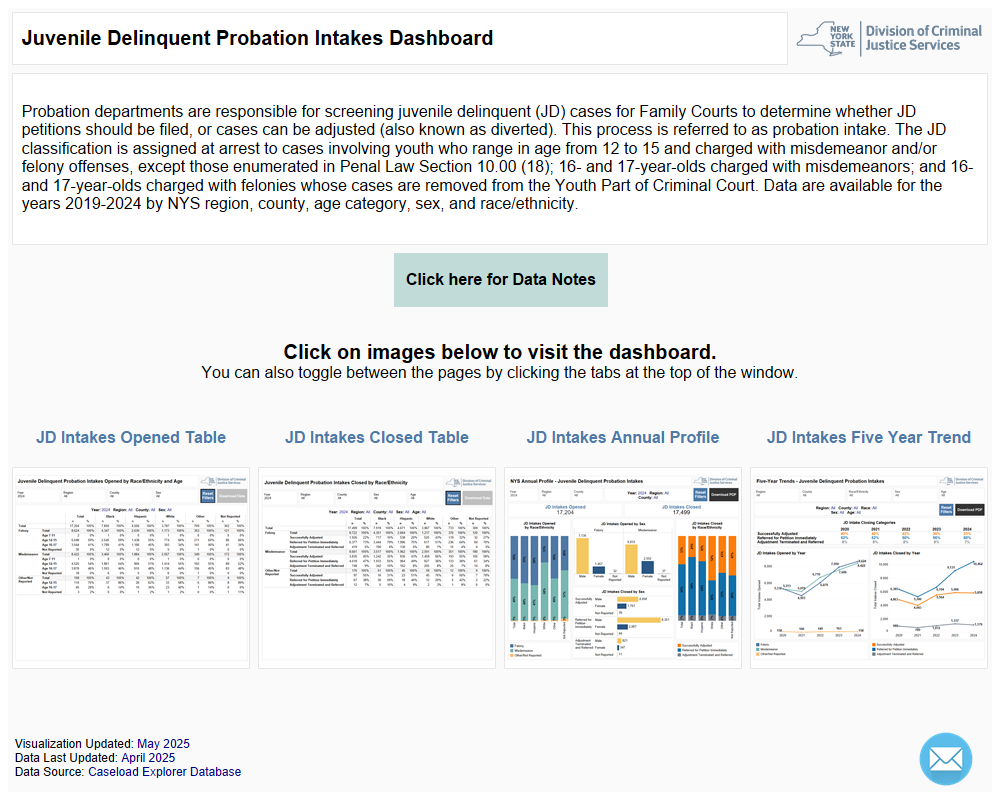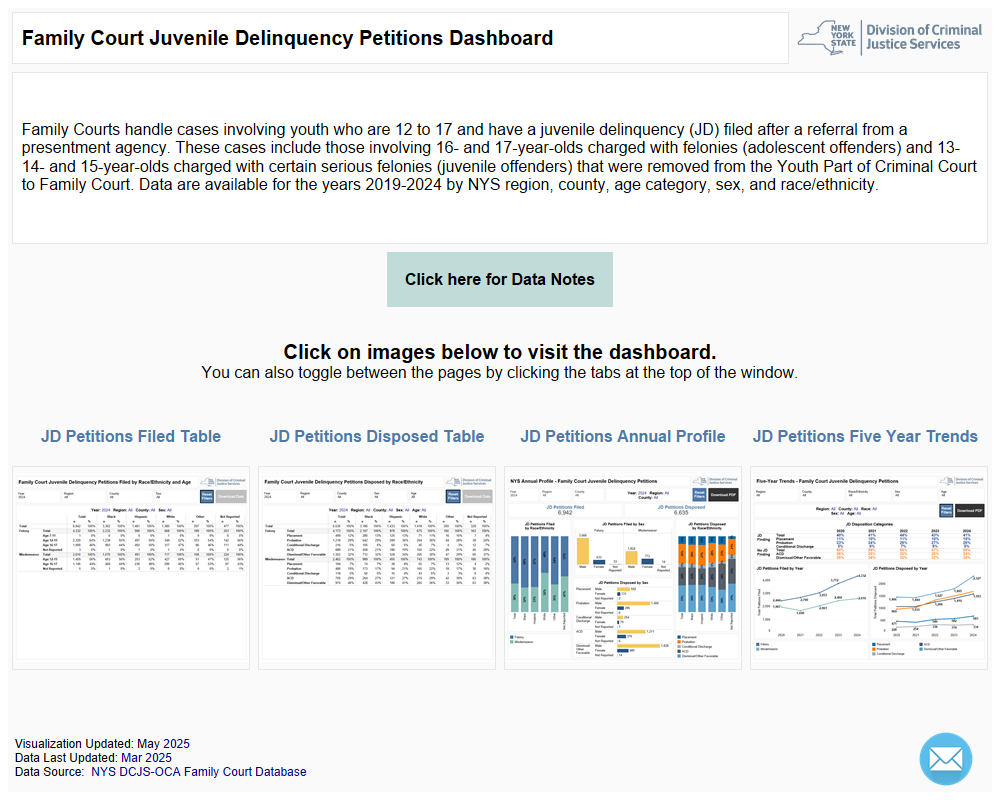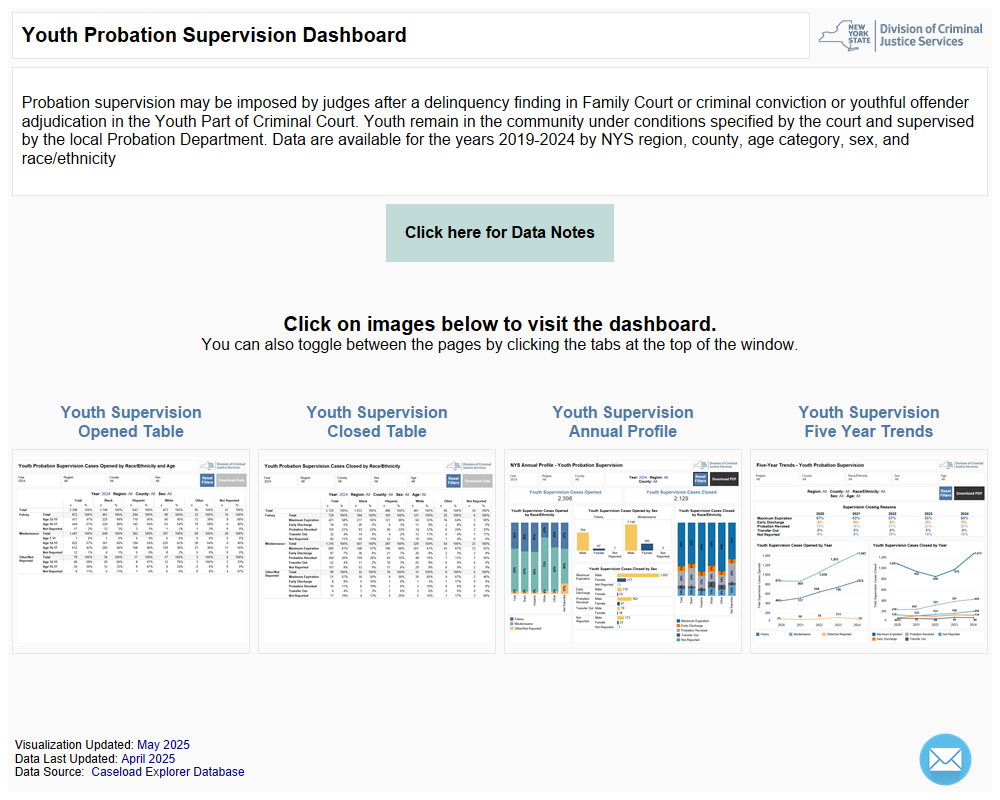Criminal Justice Statistics
The Division of Criminal Justice Services maintains, analyzes and publishes criminal and youth justice system data, including incidents of crime and arrests and dispositions. Police departments, sheriffs’ offices, probation departments and the state Office of Court Administration report these data, which provide the public and policy makers with information detailing how the criminal justice system is operating in their communities. Data are presented as follows:
- Statewide: All 62 counties
- Regions: New York City (the five boroughs of Bronx, Kings, New York, Queens and Richmond) and Non-New York City (57 counties outside of the five boroughs)
- County: Each borough or county
All data that follow are updated annually except where noted and additional data are available through New York State’s Open Data portal where noted.
DCJS also publishes Criminal Justice Case Processing Reports, which contain information about misdemeanor and felony arrests and the processing of felony cases in New York State’s superior courts. These reports detail indictment and superior court information counts and outcomes of those actions, including prison sentences for cases resulting in convictions. The agency posts these reports online quarterly and annually.
In addition, the Office of Court Administration maintains and publishes criminal justice system data, including information about felony, misdemeanor and violation-level charges
Criminal justice professionals or researchers with questions or seeking additional information should contact dcjsstats@dcjs.ny.gov.
Media inquiries should be directed to pressinfo@dcjs.ny.gov.
Open All Categories | Close All Categories
Reported Crime and Victimization
Index Crime
New York State and the FBI use seven Index crime categories as indicators of overall crime trends: murder, rape, robbery and aggravated assault, which are classified as violent crimes; and the property crimes of burglary, larceny and motor vehicle theft. The FBI created these categories to allow for uniform crime reporting across all 50 states.
Police departments and sheriffs’ offices report these data to the state.
Click on an image below to be taken to the respective dashboard.
Index crime by police agency and crime rate data for each county back to 1990 are available through the Open Data Portal.
DCJS is required to annually publish a report analyzing reported crime. Crime in New York State reports are available on the Publications / Reports page.
Hate Crime
Hate crimes target individuals, groups of individuals or property based on a perception or belief about race, ethnicity, gender, sexual orientation, religion or other characteristic as defined by state law.
Police agencies determine whether a crime that occurred in their jurisdiction is classified as a hate crime and report those incidents to the state. Hate crime incidents reported to police are presented for the most recent five years.
- Hate Crime Incidents by County and Agency (12/2025)
- Hate Crime Incidents by Bias Type and Region (12/2025)
DCJS is required to annually publish a report analyzing hate crime incidents, arrests and convictions. Hate Crime in New York State reports are available on the Publications / Reports page.
Historical hate crime incidents back to 2010 are available through the Open Data Portal.
Domestic Violence
Police agencies in New York State collect data on the number of individuals victimized during domestic incidents involving members of the same family, including but not limited to parents, children and siblings, and intimate partners. These individuals may or may not live together at the time of the incident.
Police agencies in counties outside New York City report these data for the following offense categories: aggravated assault, simple assault, sex offenses, and violation of protective orders. The New York City Police Department reports these data for the following offense categories: felony assault, third-degree assault and related offenses, and violation of protective orders.
Data are presented for the most recent 10 years.
New York State annually publishes a Domestic Homicide Report analyzing homicides involving family members and intimate partners. Those reports are available on the Publications / Reports page.
Gun Violence
New York State provides funding, training and technical support to 28 police agencies and their law enforcement partners in 21 counties through the Gun Involved Violence Elimination (GIVE) initiative, which aims to reduce shootings, shooting deaths, and firearm-related violent crimes.
GIVE agencies are required to report shooting incidents involving injuries, the number of individuals shot, and the number of individuals killed by gun violence to DCJS. Those agencies are divided into two tiers:
- Tier I agencies focus on reducing the number of shootings and shooting fatalities: Albany, Buffalo, Hempstead, Mount Vernon, Nassau County, Newburgh, Niagara Falls, Poughkeepsie, Rochester, Schenectady, Suffolk County, Syracuse, Troy, Utica, and Yonkers.
- Tier II agencies focus on reducing firearm-related violent crimes (murder, rape, robbery, aggravated assault): Amherst, Auburn, Binghamton, Cheektowaga, Elmira, Greece, Ithaca, Jamestown, Kingston, Lackawanna, Middletown, Spring Valley, and Watertown.
Reports including Shooting Incidents, Shooting Victims, and Shooting Homicides
- Monthly GIVE Shooting Activity (12/2025)
- Annual GIVE Shooting Activity (5/2025)
Click on the image below to be taken to the interactive dashboard
Agency level reported crime data and violent crime by firearm data are available in dashboard format on the Index Crime tab of the Statistics Page.
Adult Criminal Justice System
This section provides data detailing processing of cases involving individuals who are 18 and older.
Adult Arrests
Arrest data is derived from the Division of Criminal Justice Services (DCJS) Computerized Criminal History (CCH) system. CCH contains arrests for offenses where fingerprints are required to be taken (Criminal Procedure Law 160.10). Arrest information is submitted by police departments and sheriffs’ departments. Arrests involve individuals 18 or older when the alleged crime was committed.
Click on an image below to be taken to the respective dashboard.
Historical adult arrest data back to 1990 are available through the Open Data Portal.
Adult Convictions
Conviction data is derived from the Division of Criminal Justice Services (DCJS) Computerized Criminal History (CCH) system. CCH contains convictions for offenses where fingerprints were required to be taken pursuant to Criminal Procedure Law 160.10. Conviction information is submitted by the Office of Court Administration (OCA). Convictions involve individuals who were age 18 or older when the crime was committed and have since been sentenced.
Click on the image below to be taken to the interactive dashboard
Pretrial Release
State law requires the Division of Criminal Justice Services (DCJS) and the Office of Court Administration (OCA) to provide information to the public that details pretrial release decisions made by judges upon arraignment, including release on recognizance, bail, or non-monetary conditions, as well as remand to custody.
DCJS and OCA coordinated and compiled one comprehensive data file to meet the statutory reporting obligations because neither agency maintains all the data necessary to fulfill the requirements under the bail reform law. Data within the file include the sex, race, and ethnicity of the individual arrested; the most serious arrest charge; the number and type of charges the individual has faced previously; and if the individual failed to appear in court or was re-arrested while the case was pending, among other data. The information provided does not identify the individuals charged.
This file contains data from Jan. 1, 2020, through Dec. 31, 2024, as reported by New York City criminal courts (excluding community courts), 61 city and two district courts outside of New York City, and all Superior Courts, which started reporting data in 2021. An additional file contains data for town and village justice courts outside of New York City, which started reporting in 2023.
DCJS and OCA also coordinated and compiled a Supplemental Pretrial Release Data File, which details cases arraigned in 2019, prior to the bail law changes, and cases arraigned from 2020 through 2024.
- Supplemental Pretrial Release Data File(October 2025) – This file contains arraignments resulting from arrests requiring fingerprints from Jan. 1, 2019, through Dec. 31, 2024.
- Supplemental Pretrial Release Data File Source Notes (October 2025)
- Supplemental Pretrial Release Data Dictionary (October 2025)
- Supplemental Pretrial Release Summary Tables (October 2025)
OCA publishes a Discovery Reform: Court Activity Dashboard to satisfy Discovery Law reporting requirements in State Judiciary Law Section 216(5). DCJS Discovery Reform Reports for 2021 and 2022 are posted on the Annual Reports and Publications page.
Dispositions of Adult Arrests
Five years of data detailing the court dispositions (outcomes) of misdemeanor and felony arrests of individuals 18 and older. Arrests are reported by the police agency that made the arrest and disposition information is provided by the state Office of Court Administration.
Comparison of Population to Arrests and Prison Sentences by Race/Ethnicity
Data comparing arrests and sentences to prison by race/ethnicity as compared to the race/ethnicity of the total population in New York State, New York City, Non-New York City, and each county. These data are presented to provide context to the race/ethnicity of adults involved in the criminal justice system.
Adults Required to Register as Sex Offenders
State law requires adults convicted of certain crimes to register as sex offenders. Registration occurs upon an individual’s release to the community. The number of adults required to register are shown by risk level, county of residence and other categories. These data are updated monthly.
Adults Required to Register by County and Risk Level (12/1/2025)
State law sets three risk levels, which are determined by a judge after a court hearing: Level 1 (low risk of repeat offense), Level 2 (moderate risk of repeat offense) and Level 3 (high risk of repeat offense). A designation of P (pending) means that a judge has not yet determined risk level. Any questions about these data should be directed to pressinfo@dcjs.ny.gov.
Adults Under Probation Supervision
A sentence to probation allows individuals convicted of crimes to remain in the community under conditions mandated by the court and monitored by probation departments in 57 counties and New York City. Judges also may impose a split sentence, which is a term of local jail incarceration followed by probation supervision. New York State regulates and funds Probation Departments, however, supervision of individuals is a local responsibility.
Adults Under Probation Supervision by County (3/2025)
Adults under supervision are shown annually for the past five years and by conviction type, sex, and race/ethnicity for the most current year. See data notes for more information.
- Adults Under Supervision Annually for the Last Five Years
- Adults Under Supervision by Conviction Category
- Adults Under Supervision by Sex
- Adults Under Supervision by Race/Ethnicity
New York State annually publishes a Probation Population Report analyzing data and trends, including crimes of conviction and outcomes. Those reports are available on the Publications / Reports page.
Jail Population
New York City and each county operate local jails, which house individuals sentenced to no more than one year of incarceration, those awaiting transfer to state prison to serve a sentence and those whose court cases are pending.
State prison population data are available from the State Department of Corrections and Community Supervision.
Data detailing average daily population by facility for the most recent 12 months are updated monthly.
- Monthly Jail Population (12/2025)
Data detailing average of all daily populations reported for each year by facility for the most recent 10 years are updated annually.
- Annual Jail Population (2/2025)
Historical jail population data back to 1997 are available through the Open Data Portal.
Youth Justice System
This section provides data detailing processing of cases involving individuals who are 7 through 17 years old. This youth justice system flow chart illustrates key points in case processing. The state Office of Children and Family Services updates youth detention data and youth placement data each quarter and also produces an annual Youth in Care Report.
Youth Population Data
Statewide, regional and county population data by sex and race/ethnicity for youth ranging in age from 7 to 17. These data are presented to provide context to the race/ethnicity, sex and age of youth involved in the youth justice system.
Arrests/Criminal Activity
Five years of data detailing police contact with individuals younger than 18, either formal arrests or police contact with youth where there is probable cause that a crime was committed but the agency did not file formal charges.
Arrests and criminal activity are shown by the following categories as defined by the FBI:
Index (murder, robbery, forcible rape, aggravated assault, burglary, larceny, and motor vehicle theft) and Non-Index (all other offenses, including but not limited to arson, weapons possession, criminal mischief and simple assault).
- Arrests/Criminal Activity by County (9/2025)
Youth Probation and Family Court Processing
These dashboards show county-level and demographic information for cases at three processing points in the youth justice system:
- Juvenile Delinquent Probation Intakes - Juvenile delinquent cases screened by Probation Departments to determine whether petitions should be filed in Family Courts, or cases can be adjusted (also known as diverted) from the system.
- Family Court Juvenile Delinquency Petitions - Juvenile delinquent petitions filed in Family Courts by the presentment agency (either the New York City Corporation Counsel’s Office in the five boroughs, or a County Attorney’s Office in any of the 57 counties outside of New York City).
- Youth Probation Supervision - Cases disposed to probation supervision after a juvenile delinquency finding in Family Courts, or after a criminal conviction or youthful offender adjudication in the Youth Part of Criminal Courts.
Click on the image below to be taken to the interactive dashboard.
Youth Part of Criminal Court Processing
Youth Part of Criminal Court processes felony arrests involving 16- or 17-year-olds, defined in state law as adolescent offenders, and arrests involving 13-, 14- and 15-year-olds facing certain serious felony crimes, defined in state law as juvenile offenders.
These cases may remain in Youth Part or be transferred to, also referred to as removed to, Probation and/or Family Court.
Racial and Ethnic Disparities in the Youth Justice System
This dashboard contains data on juvenile delinquency (JD) cases in New York State by race and ethnicity and county. The number and racial/ethnic breakdown of cases are shown for the following case processing points in the juvenile justice system: probation intakes opened, probation intakes referred to the presentment agency, probation intakes adjusted, petitions filed in Family Court, petitions resulting in a JD finding, petitions resulting in no JD finding, and probation supervision cases opened. The JD classification in the youth justice system refers to the following types of cases:
- Youth 12- to 15-years-old charged with a misdemeanor or felony offense;
- Youth 16- to 17-years-old charged with a misdemeanor; or
- Youth 16- to 17-years-old charged with a felony (“Adolescent Offender”) whose cases are removed from the Youth Part of Criminal Court to Probation or Family Court.
Data represent the count and percent of cases by race/ethnicity at each case processing point in the juvenile justice system. Data represent cases at each point, not unique individuals. Data do not follow individual youth through the juvenile justice system.
For race/ethnicity, five categories are displayed: White, Black, Hispanic, Other Race/Ethnicity, and Not Reported. All cases involving youth of Hispanic ethnicity are reported in the Hispanic category, regardless of race. The Other Race/Ethnicity category includes cases of youth who are Asian/Pacific Islander, American Indian/Alaskan Native, or Other Race. Not Reported reflects cases that are missing data on race/ethnicity.
More information about the juvenile justice system, including the probation intake process, juvenile delinquency petitions, and youth probation supervision can be found by reviewing the data notes at the following links: probation intakes, petitions, probation supervision.
Population data for 2019-2020 are sourced from the Centers for Disease Control and Prevention, Division of Vital Statistics, National Center for Health Statistics. Population data for 2021-2024 are sourced from the U.S. Census Bureau; population data for 2024 utilizes 2023 population statistics. Data on Intakes Referred to Petition include cases that were referred to petition immediately and cases that received adjustment services but were ultimately referred to petition without successful adjustment.
Data Last Updated: May 2025
Data Provided by: DCJS
Law Enforcement
Law Enforcement Personnel
The number of sworn and civilian employees on each police agency's payroll, and those employees by sex, race and ethnicity, annually as of Oct. 31. These data are reported by each agency and excludes employees working in local correctional facilities.
- Sworn and Civilian Personnel (9/2025)
- Sworn Personnel by Race, Ethnicity and Sex (9/2025)
Historical police personnel data dating back to 2007 are available through the Open Data Portal.
Use of Force
State law requires police departments and sheriffs' offices to report incidents involving use of force to the state, which must make incident-level information by agency available to the public.
- Case Level Incidents by Agency: November 2020 through December 2024 (08/2025)
- Data Source Notes (08/2023)
- Summary Use of Force Data Tables: November 2020 through December 2024 (08/2025)
Note: Use of Force data from July 1, 2019, through Oct. 31, 2020, is posted on the Publications / Reports page under Archive. Due to a change in the state's data collection system, that data should not be compared to the current data.
Arrest-Related Deaths
State law requires police departments and sheriffs' offices to report incidents involving arrest-related deaths to the state, which must make incident-level information by agency available to the public.









